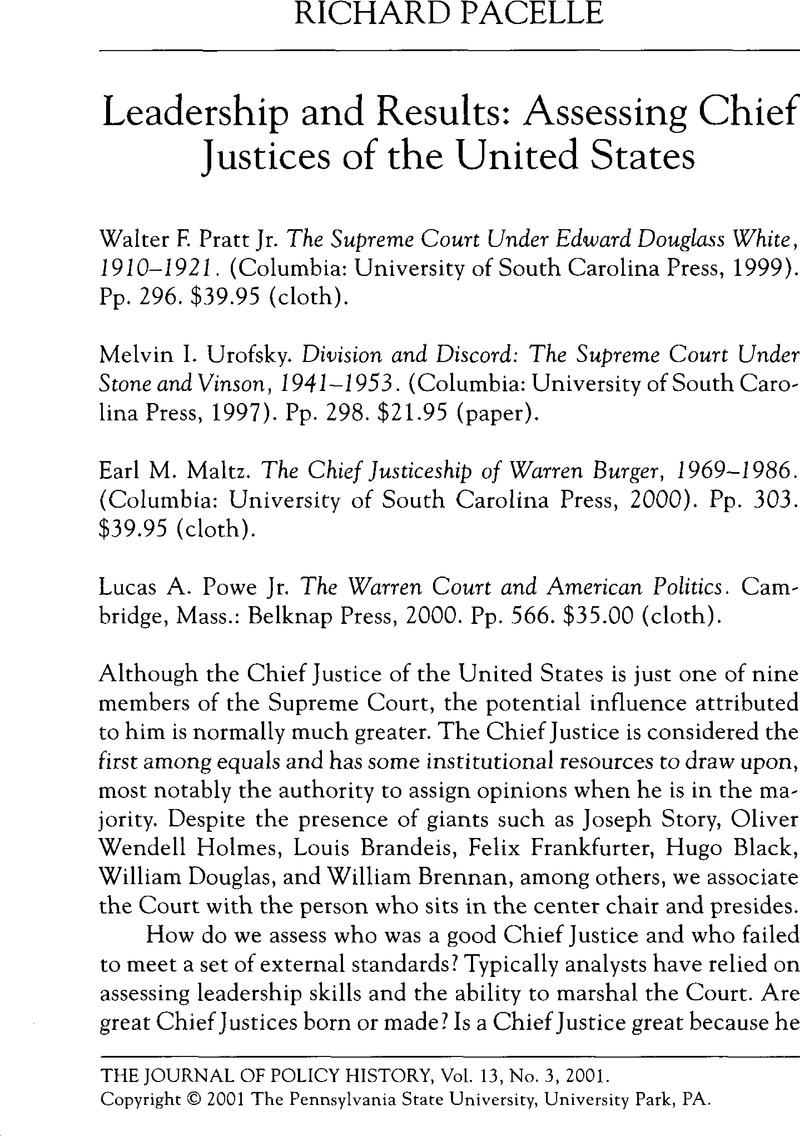No CrossRef data available.
Article contents
Leadership and Results: Assessing Chief Justices of the United States - Walter F. PrattJr. The Supreme Court Under Edward Douglass White, 1910–1921. (Columbia: University of South Carolina Press, 1999). Pp. 296. $39.95 (cloth). - Melvin I. Urofsky. Division and Discord: The Supreme Court Under Stone and Vinson, 1941–1953. (Columbia: University of South Carolina Press, 1997). Pp. 298. $21.95 (paper). - Earl M. Maltz. The Chief Justiceship of Warren Burger, 1969–1986. (Columbia: University of South Carolina Press, 2000). Pp. 303. $39.95 (cloth). - Lucas A. PoweJr. The Warren Court and American Politics. Cambridge, Mass.: Belknap Press, 2000. Pp. 566. $35.00 (cloth).
Published online by Cambridge University Press: 22 August 2017
Abstract

- Type
- Book Review
- Information
- Copyright
- Copyright © The Pennsylvania State University, University Park, PA. 2001
References
Notes
1. Danelski, David J., “The Influence of the Chief Justice in the Decisional Process of the Supreme Court,” in Goldman, Sheldon and Sarat, Austin, eds., American Court Systems (San Francisco, 1978), 506–19.Google Scholar
2. Skowronek, Stephen, The Politics Presidents Make: Leadership from JohnAdams to Bill Clinton (Cambridge, Mass., 1997).Google Scholar
3. Abraham, Henry, Justices, and Presidents, , and Senator, s: A History of the U.S. Supreme Court Appointments from Washington to Clinton, new and revised edition (New York, 1999), 181–89.Google Scholar
4. Pacelle, Richard, The Transformation of the Supreme Court's Agenda: From the New Deal to the Reagan Administration (Boulder, Colo., 1991), 168–75.Google Scholar
5. Kobylka, Joseph, “Leadership in the Supreme Court of the United States: Chief Justice Burger and the Establishment Clause,” Western Political Quarterly 42 (12 1989): 545–68.CrossRefGoogle Scholar
6. Powe, Lucas A. Jr, The Warren Court and American Politics (Cambridge, Mass., 2000), 412.Google Scholar
7. Yarbrough, Tinsley E., The Rehnquist Court and the Constitution (New York, 2000).Google Scholar
8. For two of the different perspectives, see Segal, Jeffrey and Spaeth, Harold, The Supreme Court and the Attitudinal Model (New York, 1993);Google Scholar Clayton, Cornell, “The Supreme Court and Political Jurisprudence: New and OldInstitutionalisms,” in Clayton, Cornell and Gillman, Howard, eds., Supreme Court Decision-Making: New Institutionalist Approaches (Chicago, 1999), 15–41 Google Scholar.
9. Pacelle, , The Transformation of the Supreme Court's Agenda, 84–91.Google Scholar
10. Representative of these studies are Epstein, Lee and Knight, Jack, The Choices Justices Make (Washington, D.C, 1998);Google Scholar Eskridge, William, Dynamic Statutory Interpretation (Cambridge, Mass.: Harvard University Press, 1994)Google Scholar.


